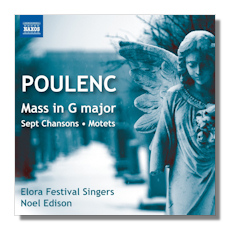
The Internet's Premier Classical Music Source
Related Links
- Poulenc Reviews
- Latest Reviews
- More Reviews
-
By Composer
-
Collections
DVD & Blu-ray
Books
Concert Reviews
Articles/Interviews
Software
Audio
Search Amazon
Recommended Links
Site News
 CD Review
CD Review
Francis Poulenc

Choral Music
- Sept Chansons
- Mass in G Major
- Four Motets for the Season of Lent
- Four Motets for the Season of Christmas
Elora Festival Singers/Noel Edison
Naxos 8.572978 54:13
Many believe Francis Poulenc's greatest works were his opera Dialogues des Carmélites (Arthaus Musik DVD 101493) and much of his sacred output, which would include his popular Gloria and Stabat Mater. If ever an opera comes close to being a sacred work – at least in spirit – it's his Dialogues des Carmélites, a work motivated largely by Poulenc's return to the Roman Catholic Church after years as a lapsed believer. Not surprisingly, the sacred works on this disc are less passionate and less dramatic in their expressive manner. But they are not emotionally neutral or cold like chant and much other sacred music. In general, the sacred works on this disc divulge a celestial, ethereal, even somewhat mystical quality. There is also a human side to the music: the Mass in G major (1937) has moments of playfulness and warmth and exudes an uplifting character. True, the Lenten motets can be austere at times, but much of that is due to the generally slow tempos and the fact that they are sung, like all the music on the disc, a cappella.
The Sept Chansons (1936) is a set of seven secular songs on French texts by Apollinaire and Éluard. In each song the text makes reference to a body part or parts: face, arms, hands, eyes, etc. While the style here resembles that of the Christmas motets, the songs are generally shorter (12:39 for the entire set), more colorful and deal with a greater range of moods. The last song, Luire (Gleaming), begins with chords Stravinsky might have written, and this is one of relatively few instances in the works on this disc where his influence can be noticed. Indeed, it's not quite as apparent in these compositions as it is in Poulenc's 1959 Gloria, for instance.
The Mass in G major features a lively opening theme for the Kyrie (the only part of the Mass sung in Greek and not in Latin) and some lovely high passages for sopranos midway through. The Gloria is brief and quite beautiful, perhaps a modest but well-crafted precursor to the aforementioned later and much bigger Gloria. The Sanctus is spirited and joyful, though in its latter half it turns stately and slightly Stravinskyan. The Benedictus is mostly gentle and angelic but, with the closing Hosanna, adopts virtually the same ending as the Sanctus. The Agnus Dei opens with a lengthy but quite lovely angular theme for solo soprano, and the mood remains quite ethereal and mesmerizing throughout. This is a fine, if modest work, well worth the attention of choral and sacred music enthusiasts.
The two sets of motets that close out the disc both feature Latin texts. The Four Motets for the Season of Lent (1938-39) are, as suggested above, a bit austere in places and clearly intended to maintain the more somber mood of the Lenten season. Indeed, the first motet opens with the words, "Fear and trembling have come upon me, and darkness has seized my soul…" Yet, the music also conveys a sense of consolation and hope. The Four Motets for the Season of Christmas (1952) are appropriately brighter, though there is also a noticeable solemnity here as well. That said, it is often tempered by a warmer and sometimes more varied expressive manner.
As for the performances, the Elora Festival Singers, under the direction of Noel Edison, sing splendidly throughout the disc. The sopranos have an especially gorgeous sound, but altos, tenors and basses are also quite impressive. Actually, not only is there no significant fault in any performance, but all the work here is excellent. The recordings were made over several days in October, 2012 and April, 2013 in St. John's Church, Elora, Ontario. One characteristic of the sound is a slight amount of reverberation, much like the kind you can get in an empty church setting. The singers seem to be recorded at a moderate distance too, but overall the sound is quite clear and well balanced. The album notes are informative. Choral and sacred music enthusiasts may well want to consider acquiring this excellent Naxos CD.
Copyright © 2015, Robert Cummings





















